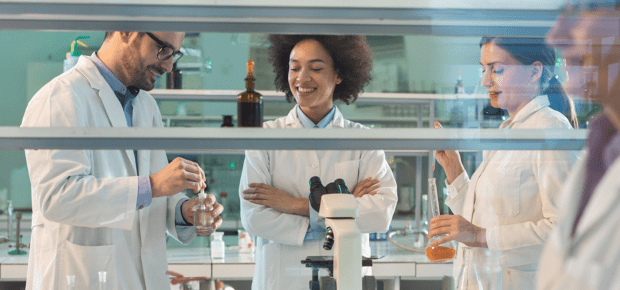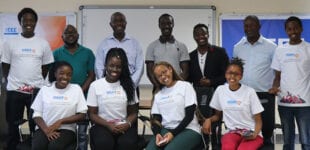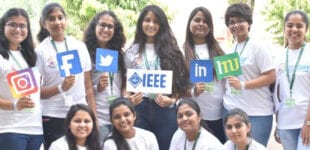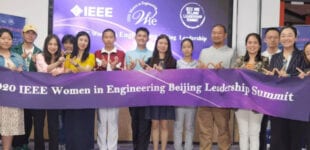April 18, 2018
In this session, they share how they are making a difference, their future predictions, and advice to anyone interested in this biomedical research.
Dr. Bruce Conklin, UCSF, is an Investigator at the Gladstone Institutes and a Professor at UCSF in Medicine, Ophthalmology, and Pharmacology. Dr. Conklin is also the Deputy Director of the Innovative Genomics Institute, focusing on Biomedical applications of CRISPR technology. His research focuses on using genome engineering to identify therapeutic approaches to human disease.
Dr. John Tisdale, NIH, is now the Chief of the Cellular and Molecular Therapeutics Section. His group focuses on developing curative strategies for sickle cell disease through transplantation of allogeneic or genetically modified autologous bone marrow stem cells.
How did you get started in your field?
Bruce: We were modeling human diseases in human iPSCs, and we needed isogenic controls. When TALENs became available, we used them to make dozens of isogenic iPS lines that have been very useful at finding mechanisms for these diseases. When CRISPR came along in 2012, we switched since CRISPR is so much easier. Soon we realized that CRISPR could be used as a therapeutic, which opens a whole new set of challenges.
John: I got started in the field after my exposure to patients with sickle cell disease and the severe pain it causes. At that time, we had only pain medicines to treat the patients, and those were reluctantly given in most centers. The lack of any specific treatment of the disease along with the fact that this is the first disease to be understood at the molecular level pushed me to begin thinking about the development of molecular tools to combat the disease.
What are some of the major challenges/obstacles you’ve had to face to reach this level of innovation so far?
Bruce: Controlled, tissue-specific delivery of CRISPR tools remains a major challenge. Since the CRISPR system is bacterially derived, it is likely that we will need to limit exposure to just a few days when immunosuppression can keep an immune reaction in check. Currently Cas9 protein delivery could be a good option, but it lacks tissue specificity. Other challenges to therapeutic editing include patient safety and regulatory issues.
John: Like any challenge in science, progress is slow, and the slow progress can be very
discouraging. Furthermore, patients with sickle cell disease face so many challenges that it makes their participation in clinical research difficult. Building a sustainable program with these challenges has proven difficult, but not insurmountable.
Thinking five years from now – what sorts of innovations do you think we’ll see in your field?
Bruce: Five years from now, therapeutic editing will be in trials for at least a dozen diseases. In addition, CRISPR will have a large role in drug discovery, where the largest public health impact will be. All of biomedical research has been accelerated by CRISPR.
Scientists are using the power of a genetic editing tool, “CRISPR,” to transform the world of medicine.
CRISPR could hold the cure to any number of genetic diseases.
However, one hundred years from now is hard to tell. In on hundred years, there are also likely to be technologies that are much more powerful than CRISPR, and all medical/genetic sciences will have advanced dramatically. Somatic editing will be a routine medical/surgical procedure. Germline editing (passed to the next generation) is also likely to be approved for specific disorders that have severe medical consequences.
What sorts of benefits does this technology bring to society at large?
Bruce: For individual patients, therapeutic editing will have the largest impact, but this is still a small number of people. The largest benefits to society as a whole will be in accelerating the development of new drugs, new foods, and the production of biotech products. Also, gene-drives to immunize disease vectors (mosquitoes) could dramatically alter the spread of insect-borne diseases such as Malaria, Dengue fever, and Lyme disease. This will probably have the largest positive affect on Africa, where insect-borne diseases are holding back development.
John: These technologies will certainly be of benefit to patients with sickle cell disease, allowing them to become engaged in society in a way that their disease prevents. Furthermore, the developments achieved in this disease setting will be relevant to a number of diseases affecting the bone marrow and beyond.
What advice would you give someone just starting out in this field?
Bruce: Enjoy science. This is a golden age in biology and a great time to be entering the field. I also always tell college students to take the opportunity to learn to communicate, since science is highly dynamic, and that requires constant communication. Make sure to take courses that require lots of writing and oral presentations. Courses like journalism, debating, history, anthropology, and social sciences are all relevant to a successful career in science.
John: My advice would be to pick a field of study wisely. Dig deep, work hard, and stay focused.
Engage, learn, and hear more from these speakers at the IEEE VIC Summit at the Palace Hotel in San Francisco, California, USA. Register to attend the IEEE VIC Summit on 11 May 2018, https://bit.ly/2DLsTso





 Liquid Infrastructure: Our Planet's Most Precious Resource
Liquid Infrastructure: Our Planet's Most Precious Resource The Impact of Technology in 2025
The Impact of Technology in 2025 Quantum and AI: Safeguards or Threats to Cybersecurity?
Quantum and AI: Safeguards or Threats to Cybersecurity? Why AI Can't Live Without Us
Why AI Can't Live Without Us Bits, Bytes, Buildings and Bridges: Digital-Driven Infrastructure
Bits, Bytes, Buildings and Bridges: Digital-Driven Infrastructure Impact of Technology in 2024
Impact of Technology in 2024 Emerging AI Cybersecurity Challenges and Solutions
Emerging AI Cybersecurity Challenges and Solutions The Skies are Unlimited
The Skies are Unlimited Smart Cities 2030: How Tech is Reshaping Urbanscapes
Smart Cities 2030: How Tech is Reshaping Urbanscapes Impact of Technology 2023
Impact of Technology 2023 Cybersecurity for Life-Changing Innovations
Cybersecurity for Life-Changing Innovations Smarter Wearables Healthier Life
Smarter Wearables Healthier Life Infrastructure In Motion
Infrastructure In Motion The Impact of Tech in 2022 and Beyond
The Impact of Tech in 2022 and Beyond Cybersecurity, Technology and Protecting Our World
Cybersecurity, Technology and Protecting Our World How Technology Helps us Understand Our Health and Wellness
How Technology Helps us Understand Our Health and Wellness The Resilience of Humanity
The Resilience of Humanity Harnessing and Sustaining our Natural Resources
Harnessing and Sustaining our Natural Resources Creating Healthy Spaces Through Technology
Creating Healthy Spaces Through Technology Exceptional Infrastructure Challenges, Technology and Humanity
Exceptional Infrastructure Challenges, Technology and Humanity The Global Impact of IEEE's 802 Standards
The Global Impact of IEEE's 802 Standards Scenes of our Cyber Lives: The Security Threats and Technology Solutions Protecting Us
Scenes of our Cyber Lives: The Security Threats and Technology Solutions Protecting Us How Millennial Parents are Embracing Health and Wellness Technologies for Their Generation Alpha Kids
How Millennial Parents are Embracing Health and Wellness Technologies for Their Generation Alpha Kids Space Exploration, Technology and Our Lives
Space Exploration, Technology and Our Lives Global Innovation and the Environment
Global Innovation and the Environment How Technology, Privacy and Security are Changing Each Other (And Us)
How Technology, Privacy and Security are Changing Each Other (And Us) Find us in booth 31506, LVCC South Hall 3 and experience the Technology Moon Walk
Find us in booth 31506, LVCC South Hall 3 and experience the Technology Moon Walk Virtual and Mixed Reality
Virtual and Mixed Reality How Robots are Improving our Health
How Robots are Improving our Health IEEE Experts and the Robots They are Teaching
IEEE Experts and the Robots They are Teaching See how millennial parents around the world see AI impacting the lives of their tech-infused offspring
See how millennial parents around the world see AI impacting the lives of their tech-infused offspring Take the journey from farm to table and learn how IoT will help us reach the rising demand for food production
Take the journey from farm to table and learn how IoT will help us reach the rising demand for food production Watch technical experts discuss the latest cyber threats
Watch technical experts discuss the latest cyber threats Explore how researchers, teachers, explorers, healthcare and medical professionals use immersive technologies
Explore how researchers, teachers, explorers, healthcare and medical professionals use immersive technologies Follow the timeline to see how Generation AI will be impacted by technology
Follow the timeline to see how Generation AI will be impacted by technology Learn how your IoT data can be used by experiencing a day in a connected life
Learn how your IoT data can be used by experiencing a day in a connected life Listen to technical experts discuss the biggest security threats today
Listen to technical experts discuss the biggest security threats today See how tech has influenced and evolved with the Games
See how tech has influenced and evolved with the Games Enter our virtual home to explore the IoT (Internet of Things) technologies
Enter our virtual home to explore the IoT (Internet of Things) technologies Explore an interactive map showcasing exciting innovations in robotics
Explore an interactive map showcasing exciting innovations in robotics Interactively explore A.I. in recent Hollywood movies
Interactively explore A.I. in recent Hollywood movies Get immersed in technologies that will improve patients' lives
Get immersed in technologies that will improve patients' lives